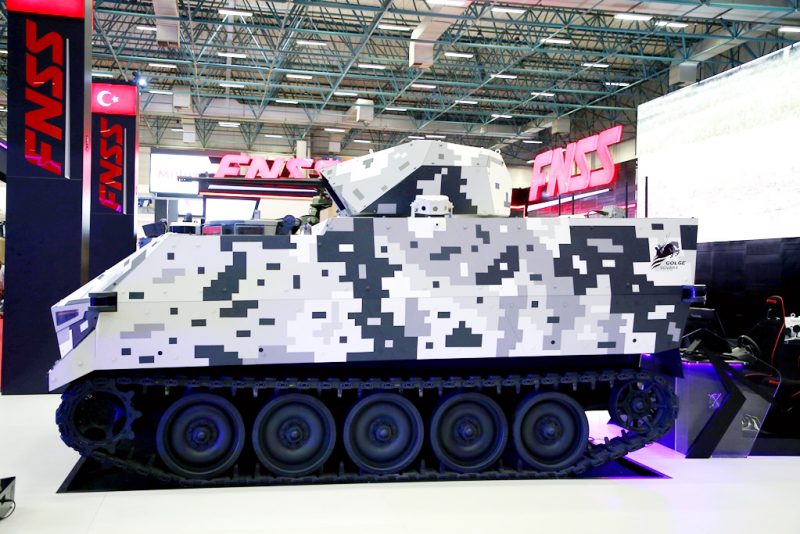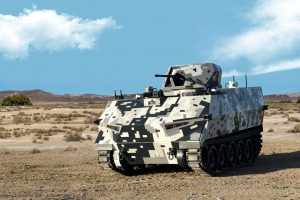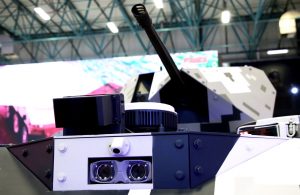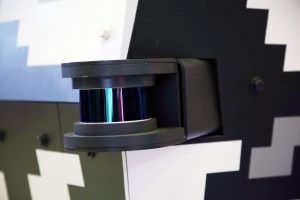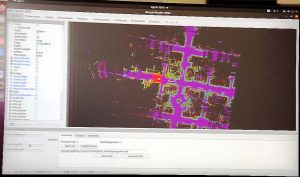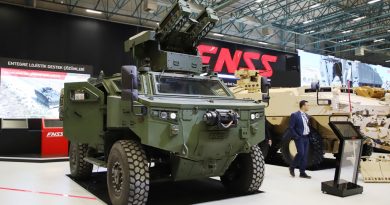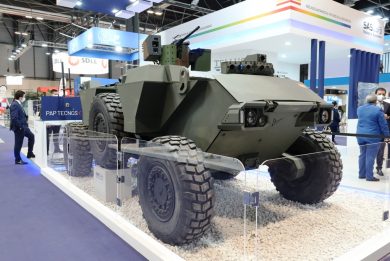FNSS Shadow Rider UGV: from tele-operation to autonomy
By Paolo Valpolini
FNSS, the joint venture between the Nurol Group and BAE Systems, has been working since 2018 on unmanned ground vehicles, its Shadow Rider, Gölge Süvari in Turkish language, being exhibited at IDEF 2019. To carry out its R&D programme FNSS chose a low-cost platform, an old M113, which makes a contrast with the modern solutions adopted to make it an unmanned and autonomous vehicle; the choice of such a platform will also allow developing a family of heavy UGVs that might well be expendable, which should be an inherent element when talking of unmanned as these are used in high risk areas, avoiding putting at risk human lives. The choice of a fully mechanical system did not simplify the task when interfaces between autonomy elements and mechanical commands must be built.
While at IDEF 2019 the Shadow Rider was exhibited as a tele-operated vehicle, at IDEF 2021 the system had considerably evolved in terms of autonomous capabilities. Return to home, obstacle detection avoidance, human recognition should dismounts operate around it, all those features were developed and added to the Gölge Süvari in its 2021 declination.
“For obstacle detection we have equipped the vehicle with five LIDAR (Light Detection and Ranging), four 32-channel sensors at the four corners of the M113 and one 64-channel at the front, where we also find two stereo cameras for operating in emergency, while a 360° situational awareness suite provides all-round vision as a safety measure,” Burak Saģ, Business Development Manager Combat and Special Purpose Vehicles tells EDR On-Line. Driving is the only autonomous operation carried out by the vehicle, which in its new variant was fitted with an unmanned turret armed with a 25 mm cannon; any firing operation obviously involving a man-in-the-loop.
The link with the operator is ensured by a two-channel system, tactical radios or commercial 5G being available. The platform is equipped with inertial and satellite navigation systems, the current autonomous suite providing waypoint navigation and patrol capabilities, as well as a leader-follower option in GNSS-denied scenarios. To this end the Shadow Rider is fitted with a TUALCOM GPS antenna that ensures protection against multiple jamming, based on CRPA (Controlled Reception Pattern Antenna) technology. “We are currently focusing on verification and qualification of our system,” Mr. Saģ explains, adding that FNSS is about to sign a contract with the Turkish Presidency of Defence Industries (SSB), the latest details being currently worked out with the aim of a signature by late 2021, early 2022. Turkish Land Forces categorise UGVs in heavy, over 10 tonnes, medium, between 2 and 10 tonnes, and light, under 2 tonnes, FNSS being obviously involved in the heavier category. The Shadow Rider is offered in many variants, fire support and surveillance, either with a 25 mm or a 12.7 mm remotely controlled weapon system, as a rotary wing drone UGV or loitering munition UGV, fitted with multiple rounds canisters, reconnaissance and surveillance with a mast mounted sensor suite, obstacle clearing, with a dozer blade and a digger, and in different mine-clearing options fitted either with a breaching system, a dozer blade for surface laid mines, or roller.
At IDEF 2021 it was possible to observe a simulated mission in which the FNSS UGV was carrying out the identification of a ground environment, its sensors being used not only for navigating but also for mapping the ground and identifying potential obstacles, which is leading to a dynamic obstacle avoidance capability, currently at TRL 4 but which should evolve into a technological demonstrator by year end, to be delivered to customer within 2022 to get users’ feedback. This would considerably enhance the system autonomy. A two console system was exhibited, one being the operators control seat, which allowed eventually the operator to take over bringing back the system to tele-operation, while the second showed the data provided by the autonomy suite. The screen was subdivided into five areas. The left main windows on top was devoted to show the computer-generated top-view based on signals obtained by all LIDAR sensors, while on the right we could see the view provided by the 64-channel front LIDAR. Three smaller windows were visible at the screen bottom showing from left to right the day view provided by stereo cameras, a fisheye view based on all LIDARs, and the thermal stereo view.
The M113 used as a platform for the Shadow Rider is fitted with a diesel engine, has a range in excess of 450 km, can reach a speed of over 50 km/h on road, with typical M113 obstacle crossing capability, and has a 4,500 kg payload. The R&D effort undertaken by FNSS might well migrate towards optionally-piloted vehicles based on the company vehicles portfolio, something that should be relatively easy to do as many of the most recent vehicles being less mechanic and more digital.
Photos courtesy FNSS and P. Valpolini

